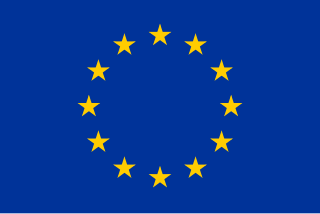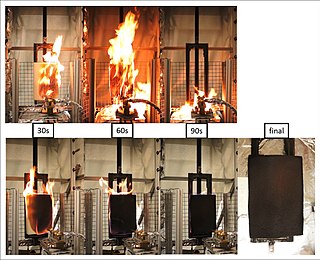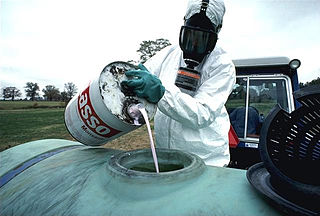Related Research Articles

A cigarette is a narrow cylinder containing a combustible material, typically tobacco, that is rolled into thin paper for smoking. The cigarette is ignited at one end, causing it to smolder; the resulting smoke is orally inhaled via the opposite end. Cigarette smoking is the most common method of tobacco consumption. The term cigarette, as commonly used, refers to a tobacco cigarette, but the word is sometimes used to refer to other substances, such as a cannabis cigarette or a herbal cigarette. A cigarette is distinguished from a cigar by its usually smaller size, use of processed leaf, different smoking method, and paper wrapping, which is typically white.

The Restriction of Hazardous Substances Directive 2002/95/EC, short for Directive on the restriction of the use of certain hazardous substances in electrical and electronic equipment, was adopted in February 2003 by the European Union.
Proposition 65 is a California law passed by direct voter initiative in 1986 by a 63%–37% vote. Its goals are to protect drinking water sources from toxic substances that cause cancer or birth defects and to reduce or eliminate exposures to those chemicals generally, such as in consumer products, by requiring warnings in advance of those exposures, with the intended goal being that companies choose to reformulate their products without the substances rather than simply providing notice of such substances in their product.
Polybrominated diphenyl ethers or PBDEs, are a class of organobromine compounds that are used as flame retardants. Like other brominated flame retardants, PBDEs have been used in a wide array of products, including building materials, electronics, furnishings, motor vehicles, airplanes, plastics, polyurethane foams, and textiles. They are structurally akin to polychlorinated diphenyl ethers (PCDEs), polychlorinated biphenyls (PCBs) and other polyhalogenated compounds, consisting of two halogenated aromatic rings. PBDEs are classified according to the average number of bromine atoms in the molecule. The life-saving benefits of fire retardants led to their popularization. Standards for mass transit vehicles continues to increase as of 2021.

Flame retardants are a diverse group of chemicals that are added to manufactured materials, such as plastics and textiles, and surface finishes and coatings. Flame retardants are activated by the presence of an ignition source and prevent or slow the further development of flames by a variety of different physical and chemical mechanisms. They may be added as a copolymer during the polymerisation process, or later added to the polymer at a moulding or extrusion process or applied as a topical finish. Mineral flame retardants are typically additive, while organohalogen and organophosphorus compounds can be either reactive or additive.

The Toxic Substances Control Act (TSCA) is a United States law, passed by the 94th United States Congress in 1976 and administered by the United States Environmental Protection Agency (EPA), that regulates chemicals not regulated by other U.S. federal statutes, including chemicals already in commerce and the introduction of new chemicals. When the TSCA was put into place, all existing chemicals were considered to be safe for use and subsequently grandfathered in. Its three main objectives are to assess and regulate new commercial chemicals before they enter the market, to regulate chemicals already existing in 1976 that posed an "unreasonable risk of injury to health or the environment", as for example PCBs, lead, mercury and radon, and to regulate these chemicals' distribution and use.
Brominated flame retardants (BFRs) are organobromine compounds that have an inhibitory effect on combustion chemistry and tend to reduce the flammability of products containing them. The brominated variety of commercialized chemical flame retardants comprise approximately 19.7% of the market. They are effective in plastics and textile applications like electronics, clothes, and furniture.

A fire retardant is a substance that is used to slow down or stop the spread of fire or reduce its intensity. This is commonly accomplished by chemical reactions that reduce the flammability of fuels or delay their combustion. Fire retardants may also cool the fuel through physical action or endothermic chemical reactions. Fire retardants are available as powder, to be mixed with water, as fire-fighting foams and fire-retardant gels. Fire retardants are also available as coatings or sprays to be applied to an object.

Electronic waste describes discarded electrical or electronic devices. It is also commonly known as waste electrical and electronic equipment (WEEE) or end-of-life (EOL) electronics. Used electronics which are destined for refurbishment, reuse, resale, salvage recycling through material recovery, or disposal are also considered e-waste. Informal processing of e-waste in developing countries can lead to adverse human health effects and environmental pollution. The growing consumption of electronic goods due to the Digital Revolution and innovations in science and technology, such as bitcoin, has led to a global e-waste problem and hazard. The rapid exponential increase of e-waste is due to frequent new model releases and unnecessary purchases of electrical and electronic equipment (EEE), short innovation cycles and low recycling rates, and a drop in the average life span of computers.

The Consumer Federation of California (CFC) is a nonprofit consumer advocacy organization founded in 1960. CFC campaigns for state and federal laws and appears at the California state legislature in support of consumer-focused regulations. The Consumer Federation of California is led by Executive Director Robert Herrell and President Richard Holober.

The California Department of Toxic Substances Control is an agency of the government of the state of California which protects public health and the environment from hazardous waste. DTSC is part of the California Environmental Protection Agency, with one thousand employees, and is headquartered in Sacramento. As of 2023, DTSC has regional offices in Berkeley, Chatsworth, Clovis, Commerce, Cypress, El Centro and San Diego and environmental chemistry laboratories in Berkeley and Pasadena. Meredith Williams has served as the director of DTSC since 2019.

The Office of Environmental Health Hazard Assessment, commonly referred to as OEHHA, is a specialized department within the cabinet-level California Environmental Protection Agency (CalEPA) with responsibility for evaluating health risks from environmental chemical contaminants.

Electronic waste or e-waste in the United States refers to electronic products that have reached the end of their operable lives, and the United States is beginning to address its waste problems with regulations at a state and federal level. Used electronics are the quickest-growing source of waste and can have serious health impacts. The United States is the world leader in producing the most e-waste, followed closely by China; both countries domestically recycle and export e-waste. Only recently has the United States begun to make an effort to start regulating where e-waste goes and how it is disposed of. There is also an economic factor that has an effect on where and how e-waste is disposed of. Electronics are the primary users of precious and special metals, retrieving those metals from electronics can be viewed as important as raw metals may become more scarce
The California Green Chemistry Initiative (CGCI) is a six-part initiative to reduce public and environmental exposure to toxins through improved knowledge and regulation of chemicals; two parts became statute in 2008. The other four parts were not passed, but are still on the agenda of the California Department of Toxic Substances Control green ribbon science panel discussions. The two parts of the California Green Chemistry Initiative that were passed are known as AB 1879 : Hazardous Materials and Toxic Substances Evaluation and Regulation and SB 509 : Toxic Information Clearinghouse. Implementation of CGCI has been delayed indefinitely beyond the January 1, 2011.

Pesticide regulation in the United States is primarily a responsibility of the Environmental Protection Agency (EPA). In America, it was not till the 1950s that pesticides were regulated in terms of their safety. The Pesticides Control Amendment (PCA) of 1954 was the first time Congress passed guidance regarding the establishment of safe limits for pesticide residues on food. It authorized the Food and Drug Administration (FDA) to ban pesticides they determined to be unsafe if they were sprayed directly on food. The Food Additives Amendment, which included the Delaney Clause, prohibited the pesticide residues from any carcinogenic pesticides in processed food. In 1959, pesticides were required to be registered.
The health effects of electronic cigarettes (e-cigarettes) include a range of potential risks such as exposure to toxic chemicals, the possibility of increased likelihood of respiratory and cardiovascular diseases, and concerns about their possible role in cancer development. Upon their introduction, there were marketing claims that they were a safer alternative to traditional tobacco products.
Silent Spring Institute is a nonprofit organization dedicated to studying and reporting primarily on breast cancer prevention, although its research covers other health-related topics as well.
Women's Voices for the Earth (WVE) is a feminist, women-led, North American environmental organization that specializes in research and advocacy regarding toxic chemicals used in products that disproportionately impact women's health, including cosmetics, menstrual care products, professional salon and cleaning products. WVE is a non-profit organization whose mission is to amplify women's voices to eliminate toxics that harm communities and health. With its inclusive vision of environmental work WVE has become a hub for visionary feminist environmentalism that recognizes the systemic connections between health, class, race, and the environment. Addressing the inter-connectivity of these various channels of exposure to toxic chemicals has been key to WVE's approach which is multi-scalar: targeting consumer behaviors, corporate practices, and government policies.

The chemical composition of the electronic cigarette aerosol varies across and within manufacturers. Limited data exists regarding their chemistry. However, researchers at Johns Hopkins University analyzed the vape clouds of popular brands such as Juul and Vuse, and found "nearly 2,000 chemicals, the vast majority of which are unidentified."

A vape shop is a retail outlet specializing in the selling of vaping products, though shops selling derived psychoactive cannabis products have increased in the United States since the passage of the 2018 Farm Bill. There are also online vape shops. A vape shop offers a range of vaping products. The majority of vape shops do not sell vaping products that are from "Big Tobacco" companies. In 2013, online search engine searches on vape shops surpassed searches on e-cigarettes. Around a third of all sales of vaping products in one US state took place in vape shops. Big Tobacco believes the independent vape market is a threat to their interests.
References
- ↑ Annys Shin, "Taking Lead Safety Into Its Own Hands". The Washington Post , November 10, 2007. accessed March 8, 2015
- ↑ California Office of Environmental Health Hazard Assessment, "Proposition 65 in Plain Language!". accessed March 8, 2015
- ↑ CNN, "Study: Some home water filters may make lead problem worse". June 18, 1998. Accessed March 8, 2015
- ↑ Alex Barnum, "Home-Filtered Water Fails Lead Test". San Francisco Chronicle, June 19, 1998. Accessed March 8, 2015
- 1 2 3 4 Clifford Rechtschaffen, "The Continued Success of Proposition 65 in Reducing Toxic Exposures". Environmental Law Institute, 35 ELR 10830 (2005). Accessed March 8, 2015
- ↑ New York State Department of Environmental Conservation, "Lumber Pressure Treated With Chromated Copper Arsenate". Accessed March 8, 2015
- ↑ Jane Kay, "Firms phasing out arsenic compound". San Francisco Chronicle , November 11, 2001. Accessed March 16, 2015
- ↑ Sheila D'Amico, "Hazardous Medical Waste Still Burns on High Street". Archived 2015-04-27 at the Wayback Machine McArthur Metro, December 2000. Accessed March 8, 2015
- ↑ Dick Russell, "Health Problem at the Health Care Industry". Archived 2016-03-05 at the Wayback Machine Amicus Journal , Winter 2000. Accessed March 8, 2015
- ↑ Janine DeFao, "Oakland medical waste incinerator to shut down". San Francisco Chronicle, December 8, 2001. Accessed March 15, 2015
- ↑ Jane Kay, "Group wants lead out of baby powder". San Francisco Examiner, November 19, 1999 Accessed March 8, 2015
- ↑ Jennifer Yu Sacro, "Proposition 65 and Food: You Have Now Been Warned". American Bar Association Business Law Today. May/June 2009. Accessed March 8, 2015
- ↑ State of California Office of the Attorney General, "Attorney General Lockyer Announces Settlement With Hershey and Mars Subsidiaries To Reduce Lead In Mexican Candy Popular with Children". Press release, June 29, 2006. Accessed March 8, 2015
- ↑ Candace Heckman, "Lead risk cited for toy jewelry sold in vending machines". Seattle Post Intelligencer, July 8, 2004. Accessed March 16, 2015
- ↑ Janine Defao, "71 firms agree to sell kids' jewelry with reduced lead". San Francisco Chronicle, January 28, 2006. Accessed March 16, 2015
- ↑ Marc Lifsher, "Toy may have high lead level". Los Angeles Times, October 11, 2007. Accessed March 16, 2015
- ↑ Douglas Fischer, "Nonprofit finds big problems in kids' products". Oakland Tribune/Inside Bay Area, February 3, 2008. Accessed March 16, 2015
- ↑ Mike Lee, "Landmark toxics law celebrates 25 years". Archived 2020-05-18 at the Wayback Machine U-T San Diego, July 23, 2011. Accessed March 16, 2015
- ↑ Jane Kay, "Lawsuit claims lead levels in purses too high". San Francisco Chronicle, June 25, 2009. Accessed March 16, 2015.
- ↑ Lisa Fletcher, "Lead Found in Women's Handbags". ABC News, January 22, 2010. Accessed March 16, 2015
- ↑ Linda Doell, "Wal-Mart, Macy's, other retailers agree to cut lead in purses, belts and shoes". Daily Finance, June 4, 2010. Accessed March 16, 2015
- ↑ Elisabeth Leamy, "Purses With Lead Sold at Popular Retailers, Consumer Group Finds". ABC News, June 20, 2012. Accessed March 16, 2015
- ↑ Deborah Blum, "Fashion at a Very High Price". The New York Times, December 20, 2013. Accessed March 16, 2015
- ↑ Allison Aubrey, "Coke Changed Caramel Color To Avoid Cancer Warning; Pepsi In Transition". National Public Radio, July 3, 2013. Accessed March 16, 2015
- ↑ Elaine Watson, "Pepsi Strikes Deal with Health Advocacy Group Over 4-mei Levels in Soft Drinks". Food Navigator, September 17, 2015. Accessed August 31, 2016
- ↑ Amy Westervelt, "Target, Walmart, Babies-R-Us Sued Over Toxic Baby Products". Forbes, December 6, 2012. Accessed March 16, 2015
- ↑ Stephanie Lee, "Toxic nap mats draw suit in Oakland". San Francisco Chronicle, February 19, 2013. Accessed March 16, 2015
- ↑ "California Prop 65 flame retardant lawsuit settlement reached". Chemical Watch, January 29, 2014. Accessed via google news, March 16, 2015
- ↑ Gary Cohn, "Flame Retardant Bill Wins Important Industry Support". Capital and Main, August 25, 2014. Accessed March 16, 2015
- ↑ "Governor Signs Leno Bill Informing Consumers about Flame Retardant Chemicals in Furniture". Archived 2015-01-17 at the Wayback Machine Senator Mark Leno news release, September 30, 2014. Accessed March 16, 2015.
- ↑ Joe Rihn, "Offices Pledge They'll Buy Chemical-Free Furniture". Capital and Main, December 16, 2014. Accessed August 31, 2016.
- ↑ Gregg P. Macey, et al. "Air concentrations of volatile compounds near oil and gas production: a community-based exploratory study". Environmental Health 2014, 13:82 October 30, 2014. Accessed March 16, 2015
- ↑ Allen Neuhauser, "Study Links Fracking to Infertility, Miscarriages, Birth Defects". US News & World Report, December 5, 2014. Accessed March 16, 2015
- ↑ Gary Walker, "Getting the Lead Out" Archived 2020-06-12 at the Wayback Machine . The Argonaut, February 18, 2015. Accessed August 30, 2016. Also Barry Eberling, "Lead fuel warning signs to go up at Napa Airport". Napa Valley Register, February 17, 2015. Accessed August 31, 2016.
- ↑ Chase Scheinbaum, "Vaping Products Under Fire". KCET, February 5, 2015. Accessed August 31, 2016.
- ↑ Justin Worland, "Health Watchdog Group to Challenge E-Cig Manufacturers in Court". Time . September 2, 2015. Accessed August 31, 2016.
- 1 2 Truman Lewis, "Lawsuit charges e-cigarettes contain cancer-causing chemicals". Consumer Affairs, November 20, 2015. Accessed August 31, 2016.
- ↑ Lydia Wheeler, "Report: Many e-cigs produce high levels of cancer-causing chemicals". The Hill, September 2, 2015. Accessed August 31, 2015.
- ↑ Sarah Boseley, "US health watchdog to take legal action against e-cigarette makers". The Guardian, September 2, 2015. Accessed August 31, 2015.
- ↑ "CEH website". Archived from the original on 2017-01-09. Retrieved 2016-08-31.
- ↑ Elizabeth Grossman, "Will the US ever pass a new chemical safety law". The Guardian, March 12, 2015. Accessed August 31, 2015.
- ↑ Christopher Gavigan and Michael Green, "Above all, Lautenberg chemical bill doesn't put consumer safety first". NJ Star-Ledger, March 17, 2015. Accessed August 31, 2016
- ↑ Elizabeth Grossman, "Reformed Chemical Safety Law Doesn't Eliminate Need for Public Vigilance". Earth Island Journal, June 23, 2016. Accessed August 31, 2016.
- ↑ Jeremy B. White, "California pulls back on BPA warnings, angering advocates". Sacramento Bee, March 24, 2016. Accessed August 31, 2016.
- ↑ Ramin Skibba, "California's struggle over the chemical BPA continues". San Jose Mercury News, July 2, 2016. Accessed August 31, 2016
- ↑ Michael Green and Sam Mogannam, "Consumers should tell California to enforce BPA warning rule". Archived 2017-09-21 at the Wayback Machine San Francisco Chronicle, August 11, 2016. Accessed August 31, 2016
- ↑ "The Missing Peace - Peace & Art". 2012-04-17. Archived from the original on 2012-04-17. Retrieved 2021-10-15.
- ↑ Michele Chandler, "Center for Environmental Health crusades". San Francisco Business Times, June 13, 2010. Accessed March 16, 2015